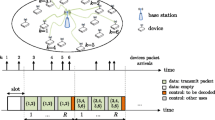Abstract
Future wireless systems will need to cope with highly dispersive channels in order to support high data rates. A slotted Prefix-assisted DS-CDMA allows the multiplexing of various Mobile Terminals (MTs) at the uplink with appropriate Frequency Domain Equalization (FDE) to support the dispersive channels. However data packets can be received with errors due to channel interference or from a deep fade that persists for several slots; to cope with those errors a type II Hybrid Automatic Repeat reQuest (H-ARQ) protocol could be employed to re-use the signals from past packet copies to diminish errors. Most wireless CDMA models that employ H-ARQ assume a simplified characterization of the wireless channel, based on an average Signal to Interference-Noise Ratio (SINR), with simultaneous data transmissions from the MTs to a Base Station (BS). This paper proposes a DS-CDMA model that accounts the MTs’ channel interference and channel noise simultaneously; packet reception is possible with the aid of a linear equalization method previously published by the authors. The wireless MAC model is characterized with Discrete-Time Markov Chain (DTMC), where the delay and throughput are obtained for a Poisson packet generator. The performance of the wireless model shows accurate results against the simulation values.
Access this chapter
Tax calculation will be finalised at checkout
Purchases are for personal use only
Preview
Unable to display preview. Download preview PDF.
Similar content being viewed by others
References
Verdu, V.: Multiuser Detection. Cambridge University Press (1998)
Costello, D., Forney, G.: Channel Coding: The Road to Channel Capacity. Proceedings of the IEEE 95, 1150–1177 (2007)
Hara, S., Prasad, R.: Overview of multicarrier CDMA. IEEE Communications Magazine 35, 126–133 (1997)
Moshavi, S.: Multi-user detection for DS-CDMA communications. IEEE Communications Magazine 34, 124–136 (1996)
Adachi, F., Garg, D., Takeda, K.: Broadband CDMA techniques. IEEE Wireless Communications 12, 8–18 (2005)
Benvenuto, N., Dinis, R., Falconer, D., Tomasin, S.: Single Carrier Modulation With Nonlinear Frequency Domain Equalization: An Idea Whose Time Has Come—Again. Proceedings of the IEEE 98, 69–96 (2010)
Ganhão, F., Dinis, R., Bernardo, L., Oliveira, R.: Analytical BER and PER Performance of Frequency-Domain Diversity Combining, Multipacket Detection and Hybrid Schemes. IEEE Transactions in Communications 60, 1–8 (2012)
Sindhu, P.: Retransmission error control with memory. IEEE Transactions on Communications 25, 473–479 (1977)
Hagenauer, J.: Rate-compatible Punctured Convolutional Codes (RPCP Codes) and Their Applications. IEEE Transactions on Communications 36, 389–400 (1998)
Levorato, M., Zorzi, M.: On the Performance of Ad Hoc Networks with Multiused Detection, Rate Control and Hybrid ARQ. IEEE Transactions on Wireless Communications 8 (2009)
Lu, B., Wang, X., Zhang, J.: Throughput of CDMA Data Networks With Multiuser Detection, ARQ, and Packet Combining. IEEE Transactions on Wireless Communications 3 (2004)
Souissi, S., Wicker, S.: A Diversity Combining DSICDMA System with Convolutional Encoding and Viterbi Decoding. IEEE Trans. on Vehicular Technology 44, 304–312 (1995)
Bigloo, A., Gulliver, T., Bhargava, V.: Maximum-Likelihood Decoding and Code Combining for DS/SSMA Slotted ALOHA. IEEE Trans. on Communications 45, 1602–1612 (1997)
Zhang, Q., Wong, T., Lehnert, J.: Performance of type-II hybrid ARQ protocol in slotted DS-SSMA packet radio systems. IEEE Trans. Commun. 47, 281–290 (1999)
Prakash, R., Veeravalli, V.: Analysis of code division random multiple access systems with packet combining. In: Proc. 33rd Asilomar Conf. Signals, Systems & Computers (2000)
Telatar, I., Gallager, R.: Combining queueing theory with information theory for multiaccess. IEEE J. Select. Areas Commun. 13, 963–969 (1995)
Win, M., Pinto, P., Shepp, L.: A Mathematical Theory of Network Interference and Its Applications. Proceedings of IEEE 97, 205–230 (2009)
Lai, K., Shynk, J.: Analysis of the Linear SIC for DS/CDMA Signals with Random Spreading. IEEE Trans. on Signal Processing 52, 3417–3428 (2004)
Das, S., Viswanathan, H.: A Comparison of Reverse Link Access Schemes for Next-Generation Cellular Systems. IEEE Journal on Selected Areas in Communications 24, 684–692 (2006)
Takács, L.: Introduction to the Theory of Queues. Oxford University Press (1962)
Cui, S., Goldsmith, A., Bahai, A.: Energy-constrained modulation optimization. IEEE Transactions on Wireless Communications 4, 2349–2360 (2005)
Dinis, R., Montezuma, P., Bernardo, L., Oliveira, R., Pereira, M., Pinto, P.: Frequency-domain multipacket detection: a high throughput technique for SC-FDE systems. IEEE Transactions on Wireless Communications 8, 3798–3807 (2009)
Author information
Authors and Affiliations
Editor information
Editors and Affiliations
Rights and permissions
Copyright information
© 2013 Springer-Verlag Berlin Heidelberg
About this paper
Cite this paper
Ganhão, F., Vieira, J., Bernardo, L., Dinis, R. (2013). Type II Hybrid-ARQ for DS-CDMA: A Discrete Time Markov Chain Wireless MAC Model. In: Balandin, S., Andreev, S., Koucheryavy, Y. (eds) Internet of Things, Smart Spaces, and Next Generation Networking. ruSMART NEW2AN 2013 2013. Lecture Notes in Computer Science, vol 8121. Springer, Berlin, Heidelberg. https://doi.org/10.1007/978-3-642-40316-3_16
Download citation
DOI: https://doi.org/10.1007/978-3-642-40316-3_16
Publisher Name: Springer, Berlin, Heidelberg
Print ISBN: 978-3-642-40315-6
Online ISBN: 978-3-642-40316-3
eBook Packages: Computer ScienceComputer Science (R0)




